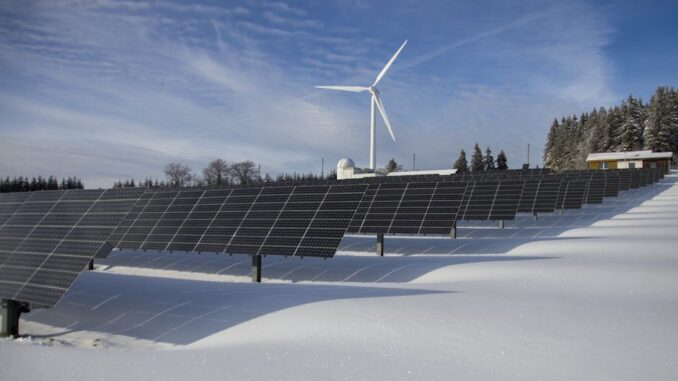
Summary
This article provides a comprehensive guide for improving energy efficiency in existing buildings. It outlines actionable steps, from assessing your current energy consumption to implementing smart technologies and renewable energy sources. By following these strategies, building owners can significantly reduce energy costs, enhance occupant comfort, and contribute to a greener future.
Successful low-energy building design hinges on careful planning. Focus360 Energy can help.
** Main Story**
Okay, so you’re looking to make your building more energy-efficient? It’s not just about hugging trees, though that’s a nice bonus. Really, it’s about saving money and creating a better space for everyone involved. Think of it as a win-win. Let’s walk through some steps you can take.
1. Know Where You Stand: The Energy Audit
First things first, you’ve gotta understand your building’s current energy habits. It’s like trying to lose weight without stepping on the scale first. Conducting a proper energy audit, is essential, it highlights where your energy is going, and where it’s being wasted. This gives you a baseline, a marker against which you can measure future improvements. I remember one building I consulted for, they were shocked to learn how much energy was being guzzled by outdated equipment they hadn’t even thought about. Surprising stuff sometimes.
2. Sealing the Deal: The Building Envelope
Your building’s ‘envelope’ – walls, roof, windows, doors – is your first defense against energy loss. A leaky envelope means wasted energy, plain and simple. So, what can you do?
- Insulation is Key: Make sure your walls, roofs, and floors have adequate insulation. It’s like wrapping your building in a cozy blanket, but for energy efficiency. You want to minimize heat transfer
- Windows and Doors Matter: Old, drafty windows and doors? They’re energy vampires! Replacing them with energy-efficient models makes a big difference. Think double-paned, low-E glass. Seal those edges up!
- Air Sealing, Seriously: Cracks and gaps in the building’s exterior? Seal ’em up! Air infiltration is a silent energy killer. You can even hire professionals to do a blower door test to find those sneaky leaks.
3. Lighting the Way (Efficiently)
Lighting accounts for a surprisingly large chunk of energy use. Time for an upgrade:
- Embrace LEDs: Ditch those old incandescent or fluorescent bulbs. LEDs are far more efficient and last much longer. I was reading about a study recently, and it stated that the transition to LED lighting across the US could save billions annually in energy costs. Crazy, right?
- Smart Lighting is Smarter: Think occupancy sensors (lights turn off when nobody’s in the room), daylight harvesting systems (adjusting lights based on natural light), and programmable timers. These maximize efficiency effortlessly. And it’s not as complicated as it sounds!
4. HVAC: The Big Energy Drinker
HVAC systems are often the biggest energy hogs. You can do a few things to improve their efficiency:
- System Upgrades, if Possible: Consider upgrading to high-efficiency HVAC units. Look for features like variable speed drives and energy recovery ventilation. It’s an investment, but it pays off. That being said…
- Maintenance is Non-Negotiable: Regular maintenance is critical. Dirty filters, leaky ducts – they all reduce efficiency. Schedule routine check-ups to keep your system running smoothly. Don’t skimp on this!
- Smart Thermostats are Your Friend: Programmable or smart thermostats allow you to control heating and cooling based on occupancy and time of day. No need to heat or cool an empty building, right?
5. Building Management System (BMS): The Brains of the Operation
A BMS is like a central nervous system for your building. It integrates all your different systems (HVAC, lighting, security, etc.) and allows for automated, optimized control. You can even use “prop tech” solutions like IoT and AI for even greater efficiency. It’s like having a smart building that manages itself. If you’re a bigger building, it’s something to really think about.
6. Harnessing the Sun: Renewable Energy
Why not generate your own clean electricity? Solar panels can significantly reduce your reliance on the grid and lower your energy costs. It requires an initial investment, obviously, but the long-term savings can be substantial.
7. Get Everyone Involved: Occupant Engagement
Don’t underestimate the power of people! Encourage energy-efficient practices among building occupants. Simple things like turning off lights, unplugging electronics, and reporting maintenance issues can make a big difference. Run campaigns to promote awareness and encourage them. I mean, you are paying the bill after all!
8. Track and Tweak: Monitoring Performance
Once you’ve implemented your upgrades, keep an eye on your building’s energy performance. Track energy consumption data and compare it to your baseline. This will help you measure the effectiveness of your efforts and identify any further opportunities for improvement. It is also important to make sure the money you invested is actually generating positive results.
So, to sum it up, boosting energy efficiency isn’t just some trendy thing to do; it’s a smart, practical move that benefits everyone. Not to mention, with a little bit of creative thinking, you can find surprising ways to save energy and money. It is an investment that pays dividends not just today, but for years to come.


“Energy vampires,” eh? I once dated one of those. Sucked the life right out of my wallet…and my building’s energy efficiency! Maybe I should have invested in better insulation back then too. Anyone have recommendations for exorcising *both* kinds of energy vampires? Asking for a friend, of course.
Haha, love the “energy vampire” analogy! Focusing on insulation is definitely a great starting point. For both the building and *ahem* other types of energy vampires, creating strong boundaries seems to be key. Perhaps some reflective window film could work as garlic for buildings? Anyone else have tips?
Editor: FocusNews.Uk
Thank you to our Sponsor Focus 360 Energy